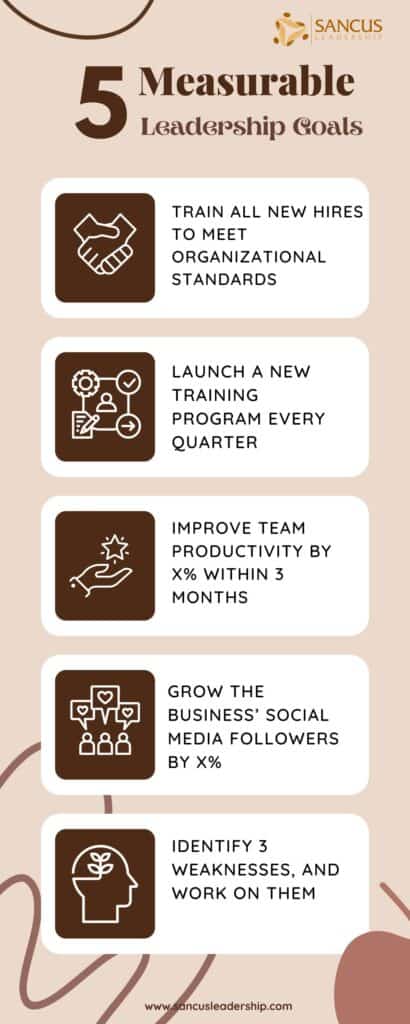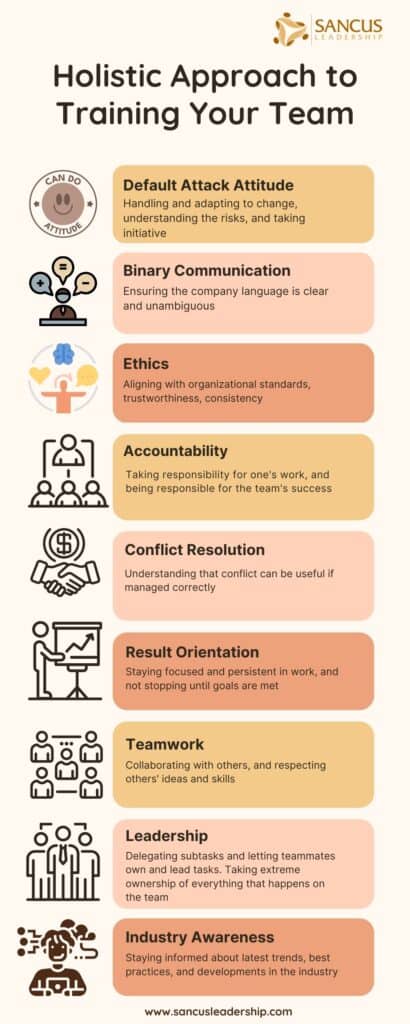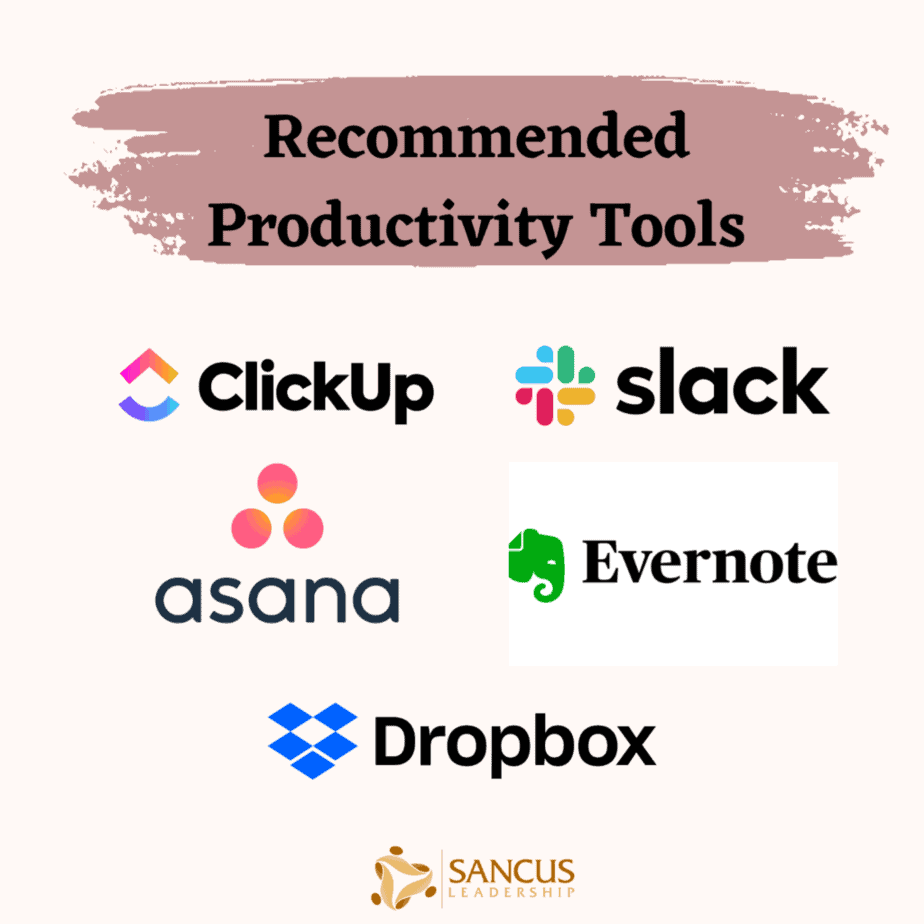As a team leader, setting leadership goals must be among your priorities at any given time to provide yourself and your team with a precise direction. Your objectives must be specific, measurable, attainable, relevant, and time-based (SMART, for short). Emphasis must be given to measurability since this allows you to track your progress and implement changes if needed.
Measurable leadership goals for team leaders may include routinely launching new training programs, increasing team productivity by a given percentage, and growing social media followers by a specific rate. You can also target your self-development by citing weaknesses you can work on regularly.

In this article, we will talk about various measurable leadership goals you can set for your team and for yourself and some valuable tips on how you can work with your team toward achieving these objectives. We will also discuss the value of setting goals that can easily be tracked through figures and timelines, as well as the importance of being realistic in setting your goals. Let’s start!
1. Train All New Hires To Meet Organizational Standards

Ensure that each person joining your team is up to par with company and team standards. To start, brief them on the organization’s goals, then fill them in on how your team’s objectives are aligned with these. Follow this up by inculcating team protocols so they can get off on the right foot and function parallel to team expectations and standards.
This leadership objective can easily be measured by the number of new individuals joining your team at any given time and dividing it by the pass rate of the end test. Give yourself a timeline — training new hires within the first week of acceptance into the team should be ideal and justifiable.
Remember that it is important to test the new hires so they actually meet the standards of the organization and not only go through the motion of the training.
Tests and evaluations, if they are set up correctly, will encourage a competitive atmosphere and increase the performance of your team and company. You can learn more about setting up effective evaluations by reaching out to me here.
2. Launch a New Training Program Every Quarter

Continuous learning and training for your team members will significantly contribute to the development and success of your business. Remember that the market is dynamic. Leading and managing your team toward success calls for you to be vigilant in ensuring that your team is always well-equipped to handle the demands of this ever-changing world.
You can either wait for the change to happen and react, or you can train your people to default attack, as we call it here at Sancus Leadership. To assume a default attack attitude means that you work proactively and look for opportunities instead of solutions.
To assume a default attack attitude means that you work proactively and look for opportunities instead of solutions.
This is vital, especially in a crisis or during adversity, and will give you the upper hand. When most companies look for solutions to get back to normal, with a default attack attitude, you will look for an opportunity to expand and improve your business.

Take on a holistic approach to training your team by focusing on a different competency per quarter. Here are some competencies you can focus on:
- Default attack attitude: Equip your team members in handling and adapting to change — an inevitable factor in any working environment. Train them to take the initiative, understand risks and move with great autonomy.
- Binary communication. Train your team members in the company’s language so words only mean one thing! Whether in written or verbal communication. Being proficient in this skill helps avoid misunderstandings and conflicts.
- Ethics. Your team members must be aligned with the standards set by the organization. Some aspects you can focus on are punctuality, trustworthiness, and consistency.
- Accountability. Training your team members to be responsible and take extreme ownership of their work.
- Conflict resolution. It is essential to train your people, so they understand that conflict can be useful if managed correctly; conflict is tension between different ideas. This tension can be exploited and used to your advantage, but without proper conflict resolution skills, they might turn into disputes.
- Result orientation. Train your team to be result-driven. This will help make them more intentional with their thoughts and actions in accomplishing tasks. This will also keep them focused and persistent in their work, never stopping until goals are met.
- Teamwork. The ability to collaborate with others is crucial to achieving set goals. Working in a team means each individual must learn to work harmoniously with others and respect their ideas and skills.
- Leadership. Leading a theme isn’t done only from the commanding position; every person on the team needs to have leadership skills. You want to delegate subtasks to teammates and let them own and lead that task. Yes, that sometimes means you will have to listen to directions from your subordinates, but it does not mean that you have less responsibility for that task. You must still take extreme ownership of everything that happens on your team.
- Industry awareness. Ensure that your team members are always abreast of the latest trends, best practices, and developments in the industry your business belongs in. You can also take training sessions as opportunities to study your competitors and identify their strengths and weaknesses.
This leadership goal can be measured by the number of High-Quality Training Programs you launch annually and how many “students” that pass.
3. Improve Team Productivity by X% Within 3 Months

Make sure to quantify your goal, so your team members will know what exactly it is they should be aiming for. Support them by providing the tools and resources they need to achieve the objective. Conduct weekly feedback sessions so that each team member is updated on where the rest of the members are in terms of progress.
Here are some tips on how you can improve your team’s productivity:
- Boost team engagement. Your team members will be more engaged with the team if they see that their efforts are appreciated and rewarded. Consider launching an incentive scheme or giving out rewards (gift checks, hotel accommodations, etc.) whenever milestones are reached.
- Minimize irrelevant pursuits. Engaging in activities unrelated to the tasks at hand will delay goal accomplishment. Discourage your team members from checking on their social media apps while at work. Be quick and to the point during meetings and provide tips on how to be organized and avoid procrastination.
- Use productivity tools. Productivity tools can help make leading and managing your team simpler. They can help make it easier for everyone on the team to monitor their progress at work.
Consider these apps:

Make sure the percentage of growth you set for this goal is realistic and attainable. Your team members may feel disheartened or intimidated if the goals are set too high. Set the goals too low, and they might start feeling diffident and low-spirited.
4. Grow the Business’ Social Media Followers by X%

Never would I have thought five years ago that I’d be sitting here and writing a post about how to gain traction on social media… but I have come to realize that this is such a vital part of running a business nowadays, so it is worth mentioning as a legit goal for your business.
I have also come to learn that social media is a great place to practice your leadership skills; you will practice your Speaking, how to engage an audience, and how to deliver instructions quickly and effectively. All of these are great leadership skills to have.
Nowadays, social media is no longer just a way for family and friends to keep in touch, show photos, or share milestones with each other. Now, social media is used by most organizations worldwide to widen their reach and boost leads and sales.
The number of people who follow you on your accounts is an indication of how well you’re able to utilize social media as a marketing tool. Followers are essentially leads that can be converted into actual customers.
Here are some ways you can enhance your social media presence and increase your followers:
- Be consistent. Post updates, photos, or videos on your social media accounts regularly — every day, if possible. The more consistent you are, the more visible you’ll be, especially with regard to search engine optimization. Make sure to always include relevant hashtags.
- Post only relevant information. Quality should be prioritized over quantity. Posting consistently doesn’t mean you should sacrifice your standards. Post only content that is HIGHLY relevant to your audience and niche down as much as possible.
- Engage your audience. Make it a habit to reply to all comments and questions on your posts. Randomly post questions to gather your audience’s opinions. Encourage your customers to post reviews so others can gain feedback on the quality of the products and services you offer.
Don’t forget to set a realistic timeline for this goal. This way, your team members will feel a sense of urgency and eagerly take on the task. Once the goal is reached, aim for a higher figure and challenge your team members to break their own records.
Social media audience building can be a fun game to play and to play with your team.
OK, enough with the Gen Z Social media hippie stuff, and let’s get back today to the fun things.
5. Identify 3 Weaknesses, and Work on Them

This is a self-development leadership goal, but it is undoubtedly one which will impact the whole team. We all have weaknesses and strengths, and leaders are in no way exempted from this.
To effectively lead and manage your team, you must know how to maximize your strengths and work on your weaknesses, so they are good enough. An excellent leader is a master at their strengths and good enough at their weaknesses!
An excellent leader is a master at their strengths and good enough at their weaknesses!
Here are some common leadership weaknesses you might be able to relate to and what you can do about them:
Control Freak
If you’re having trouble trusting your team members, then you fall into this category. You might think micromanaging your team is the best route to take to ensure productivity and success, but this is counter-intuitive.
A manager must check with their employees that they are on track toward the common goal. But this should be done by asking questions and doing inspections. It should not be done by constantly looking over someone’s shoulder; your job is to provide a what and a why; the how is up to the person closest to the problem.
Start off by delegating tasks to your team members. Take note of their strengths and maximize those to your advantage. Give them enough room to make their own decisions instead of wanting to be informed about every detail, big and small. Check on their progress weekly to ensure that everyone is on track.
Encourage them to take risks and make mistakes, And when they make mistakes, ask them what they learned from it!
And if they learned what you think they needed to, then let it go and allow them to keep taking risks. If you have another lesson for them, then provide that in a constructive and useful way, and move on.
Do not encourage creativity and then punish them with a degrading comment when they make mistakes; this is a really good way to get people disengaged and only do the minimum necessary to get a paycheck!
Overcommitment
Sometimes, you may get too wrapped up in your work that you forget about creating and respecting boundaries. Remember that your team members also need time to unwind, relax, and spend quality time with their family and friends.
Respect boundaries by ensuring that work-related matters are only discussed during work hours. Exceptions are naturally expected, especially during stressful times for the organizations (such as during a crisis or when there are deadlines), but limit interaction during these times. You may be overcommitted to your job but don’t expect the rest of the team to feel precisely the same way.
Doing it this way will allow you to have the social capital for the times when you really need people to put in their best effort. But if you ask people to give their best all the time, then you will soonly find yourself in a situation of inflation of importance. If everything is important, nothing is important.
If everything is important, nothing is important.
Stagnancy
If you’ve already established a system that works for you and your team, you may sometimes find it unnecessary to make changes. After all, why fix something that isn’t broken, right? The truth is that sometimes, you need to make changes to the established way you do things so you can keep up with the ever-changing business scene.
Avoid getting stuck in your ways by being open to your team members’ suggestions and ideas. Adapt to changes and strive to become innovative in your approach to handling different issues within the organization or the industry you belong to. Consider the feedback you get from clients so you can design new concepts that will cater to their changing needs and expectations.
Set a reasonable timeline for yourself. Depending on the magnitude of your identified weaknesses, create a timetable that will pose a tough challenge and keep you on your toes. This will motivate your team members to follow your example and pay attention to their self-development, too.
| Goal | Measurable Metric |
| Train all new hires to meet organizational standards | Number of new hires trained with a passing rate of evaluation test |
| Launch a new training program every quarter | Number of High-Quality Training Programs launched annually and number of students that pass |
| Improve team productivity by X% within 3 months | Increase in team productivity percentage after three months |
| Grow the business’ social media followers by X% | Increase in social media followers percentage after a specific period |
| Identify 3 weaknesses, and work on them | Improvements made in the identified weaknesses |
When you want to learn how to make abstract leadership goals into actionable step-by-step targets, I invite you to book a FREE discovery call with me!



